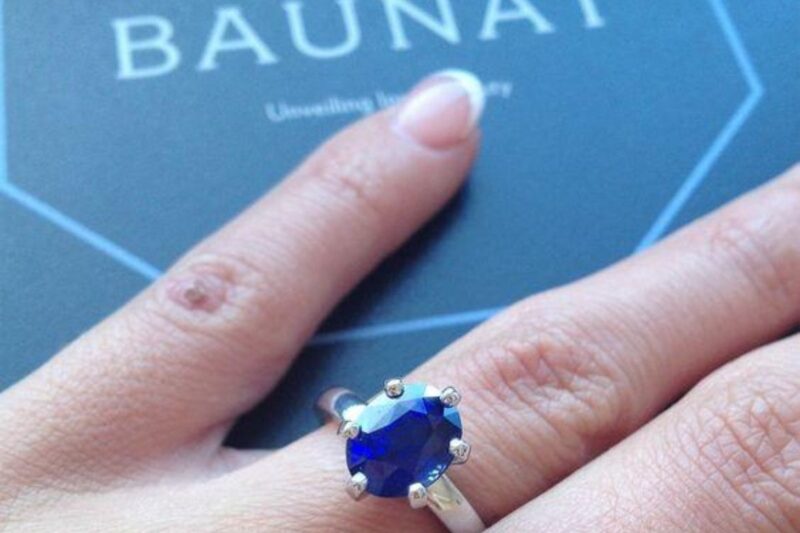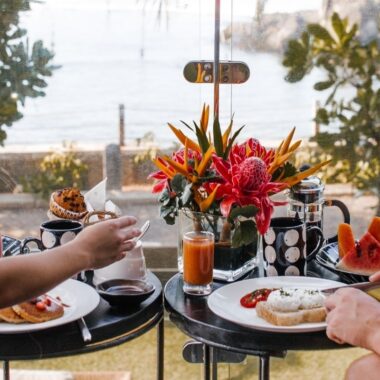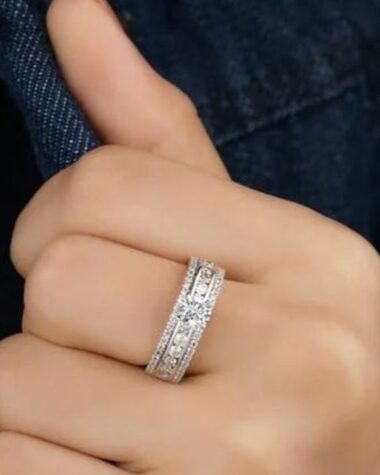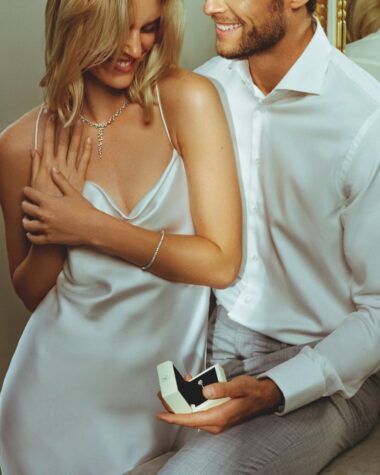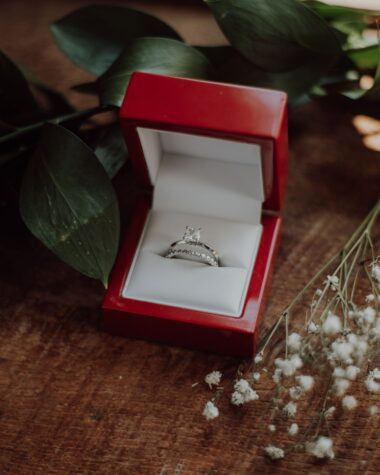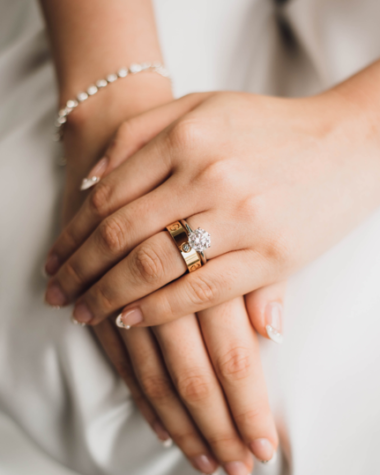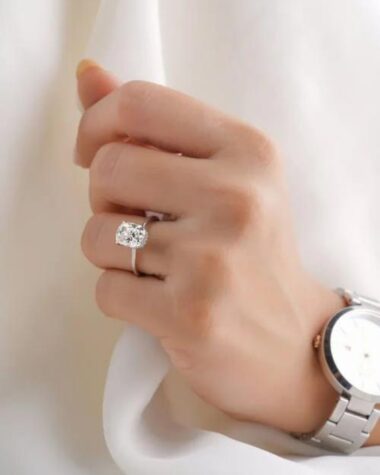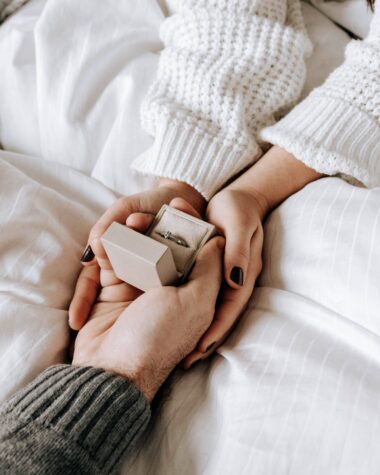Just a few decades ago, buying an engagement ring was a simple endeavour. Almost all of the rings to choose from were solitaire rings, a single diamond in a lobed setting on a plain ring of white gold, yellow gold or platinum. This classic is still by far the most popular model today, but the options have become far more diverse, with choices like never before.
What colour should the actual engagement ring be?
The basis for the engagement ring, whether set with or without stones, is the ring band. It forms the ring, which is later put on the finger. Engagement rings are often worn on the finger every day for life, so in addition to the actual colour, the durability of the material is an important consideration. Wood, stone or black carbon are therefore unsuitable as a basis for an engagement ring, they can withstand the normal stresses of everyday life only for a limited time and cannot be repaired.
Silver as a precious metal is suitable for a very inexpensive engagement ring, but it has some disadvantages: It discolours quickly and must be cleaned often, allergies occur more often than with higher quality precious metals, it is susceptible to scratches and cannot be engraved by laser.
Gold is an excellent choice for an engagement ring, it is available in three shades: As silvery white gold, classic yellow gold or romantic red or rose gold. The latter is basically red gold with a slightly softer hue, which is why the terms are sometimes used as synonyms.
The colour of gold is created by mixing pure yellow gold with other metals such as palladium, silver and copper. The finished mixture is called an alloy. Theoretically, other colours are also possible, which are less suitable for a robust engagement ring that you can keep with you for a long time. For example, green gold is too soft for a ring because cadmium or cobalt must be added. Blue gold tends not to have a uniform colour and is very difficult to work into jewelry.
In the case of gold alloys, the percentage of pure fine gold, which determines the quality of the white gold, yellow gold or red gold, is expressed in thousandths or carats. 750 gold (18 carat) therefore corresponds to 75% fine gold and 25% other metals. In the inexpensive 333 gold (8 carat), only one third is gold, two thirds are other metals. Only investment products such as gold bars or coins are made of pure 999 gold (24 carat); without additional metals it is too soft for jewelry and would easily deform. For the engagement ring 750 gold is recommended, only if you have a very tight budget 585 gold (12 carat) can be an alternative.
The popular white gold occupies a special position, because its perfect colour is not created exclusively by the precious metal itself, as is the case with yellow gold or red or rose gold, but an additional coating of rhodium. A rhodium-plated engagement ring usually requires a renewal of this electroplated coating after a few years, as abrasion can reveal the slightly yellowish pure white gold. The cost and effort for a new rhodium plating is minimal.
Are you looking for a particularly noble and hard material with a bright, silvery sheen that is also hypoallergenic and requires little care? Then platinum in the form of 950 platinum is the ideal choice. The precious metal is used in industry in many areas and is ideal for jewellery such as an engagement ring, which are subjected to everyday stresses. Platinum is slightly more expensive than gold, the processing is more complex, because it breaks more easily in the manufacturing process than the softer gold, but in return you literally get a ring for eternity.
What colours are available for the gemstone?
Gemstones exist in all colours of the rainbow, from pure, transparent white to yellow, pink, orange, red, green, blue, and even black. For engagement rings, there are particularly suitable minerals, which are among the classic gemstones: Ruby, sapphire, emerald and diamond. Regardless of your colour, they are transparent and provide a beautiful shine and sparkle when the light hits them, which has made colourless diamonds in particular the most popular choice for engagement rings.
Another advantage: gemstones are extremely hard, the emerald has a hardness of 8/10 on the Mohs scale, sapphire and ruby are at 9/10, the diamond marks the upper end with 10/10 and is the hardest mineral in the world. This hardness cannot be translated 1:1 into resilience, even diamonds are not indestructible, yet the Mohs hardness, named after the well-known mineralogist and inventor Friedrich Mohs, is a good indicator of a gemstone’s suitability for everyday use.
If you restrict yourself to the classic gemstones, red (ruby), blue (sapphire), green (emerald) are possible as colours. The diamond is an exception, because in addition to colourless diamonds, there are also natural, coloured diamonds in every conceivable hue. Here, only the budget limits the choice. Colourless, yellow, brown and black diamonds are in the affordable range for ordinary mortals. Green, blue, pink or red diamonds are extremely rare and therefore correspondingly expensive.
Which engagement ring colours suit which type?
It is crucial that the engagement ring pleases you or your loved one. Skin tone or hair colour are secondary. While there are styling guides that categorize people into types corresponding to the seasons of spring, summer, fall and winter, for example, your own taste is much more crucial.
A pragmatic approach has proven successful: since an engagement ring is usually worn every day, it should be able to be combined with other favourite pieces of jewellery and match one’s own clothing style. Therefore, when in doubt about the engagement ring colour, less is more. A classic solitaire engagement ring made of white gold or yellow gold, alternatively of the especially high-quality platinum, is much easier to wear with other jewellery and with any outfit than a very extravagant or “colourful” ring with several colours.
Also not completely unimportant is the question of what colour the wedding ring will be. In German-speaking countries, with the exception of Switzerland, both the wedding ring and the engagement ring are traditionally worn on the ring finger of the right hand after marriage. In the best case, the rings should visually complement each other and look harmonious.
